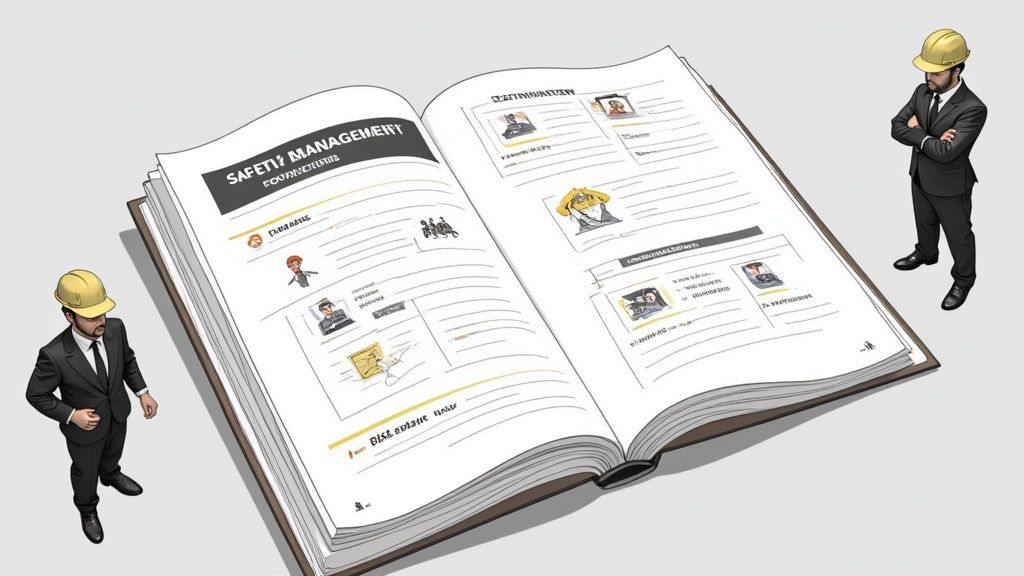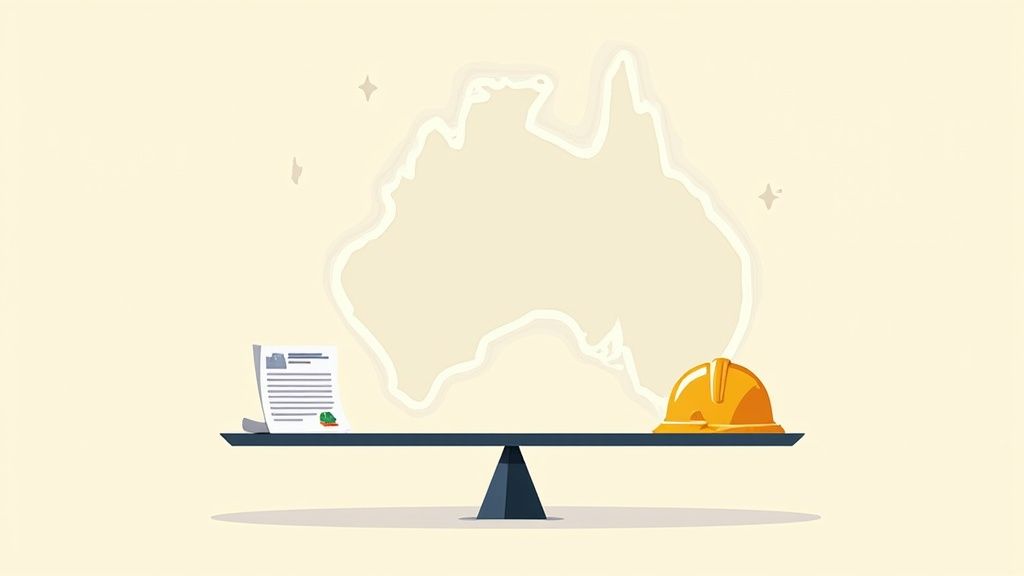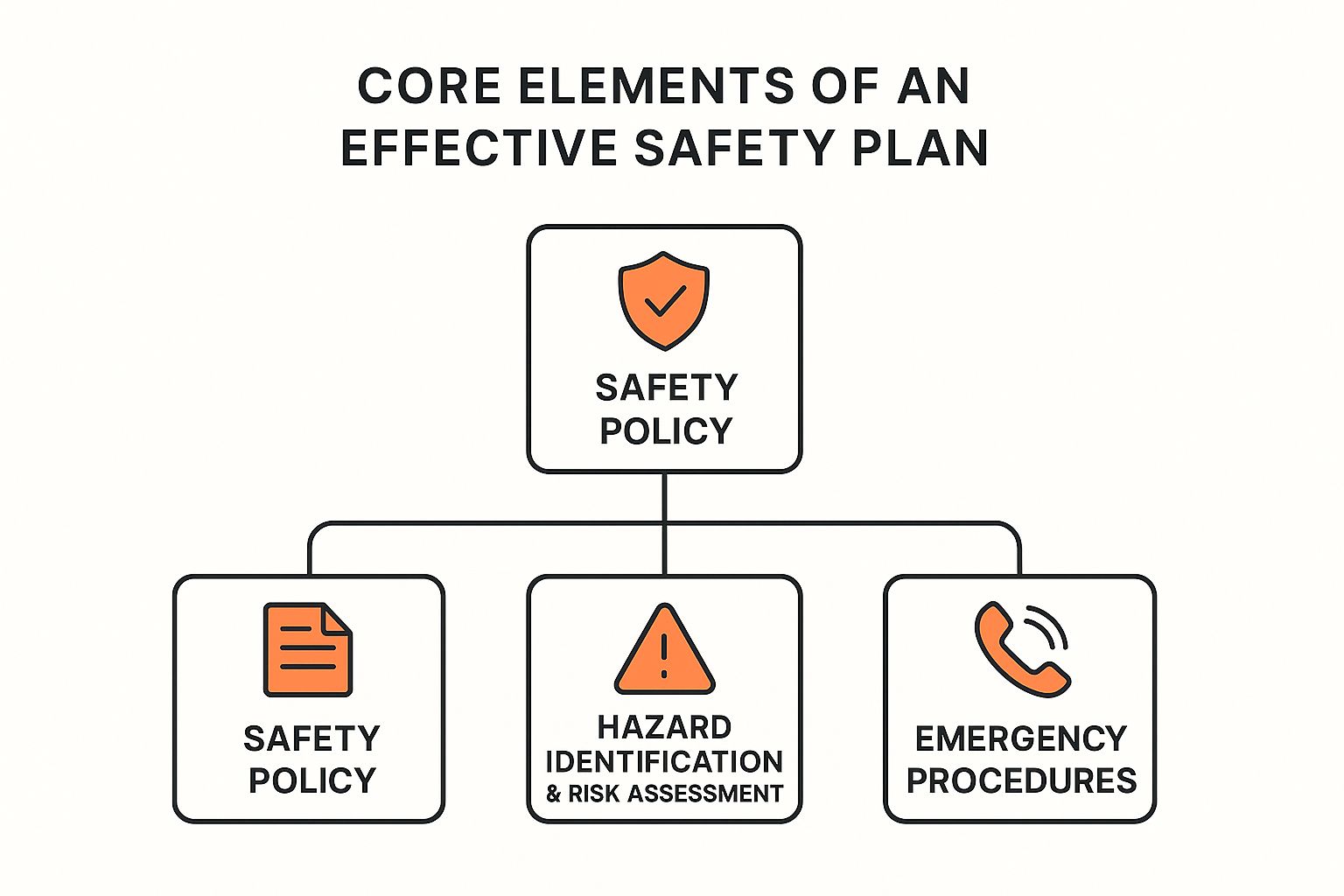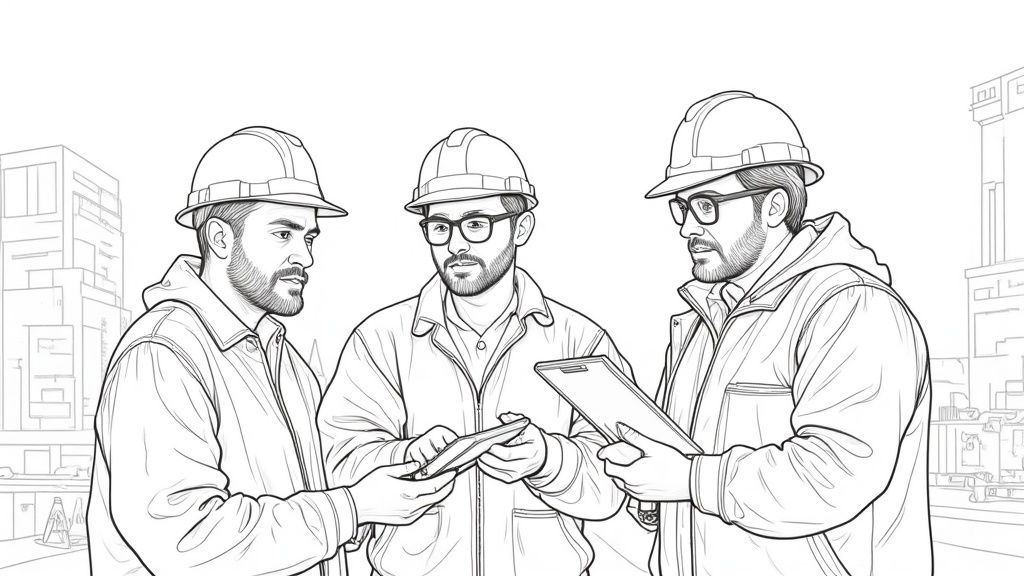Think of a safety management plan as your business's playbook for health and safety. It's the written strategy that details how you find workplace hazards, figure out the risks, and put controls in place to keep your team safe. In short, it’s the operational roadmap that protects your people while keeping your business compliant.
What a Safety Management Plan Actually Does

It’s easy to dismiss a safety management plan as just another piece of paperwork to tick a box for regulators. And yes, it absolutely fulfils legal obligations under Australian WHS laws. But its real value is in what it helps you do every single day.
This isn’t a document that should be gathering dust on a shelf. It’s a living guide for day-to-day operations, especially in high-risk environments like construction, manufacturing, or transport.
What it really does is move safety from a vague idea into a structured, manageable process. Instead of just reacting to incidents after they happen, a good plan gives you a proactive system to stop them from happening in the first place. It lays out clear procedures for everyone, from senior leadership down to the workers on the factory floor or construction site.
The Practical Benefits of a Documented Plan
Having a solid, well-defined plan isn't just about covering your bases with compliance. It's about bringing clarity and consistency to your entire safety approach. When safety procedures are formally documented, there’s no guesswork about how a task should be done safely. Everyone is working from the same script.
This creates a reliable framework that delivers some key benefits:
- Clear Responsibilities: It spells out exactly who is accountable for specific safety tasks, whether it's daily inspections, incident reporting, or emergency drills.
- Consistent Procedures: It guarantees that critical safety steps, like pre-start checks or equipment maintenance, are performed the same way, every time, by every person.
- Better Hazard Control: It provides a structured method for spotting potential dangers early and putting effective controls in place before anyone gets hurt.
- Demonstrable Due Diligence: In the event of an audit or an investigation, this plan is your concrete proof that the business is taking its safety duties seriously.
A safety management plan is not a document you create once and file away. It is the central tool you use to systematically reduce risk and build a safer workplace, day in and day out.
A solid plan gives you a central point to summarise your key safety objectives and how you'll achieve them in the real world.
Key Objectives of a Safety Management Plan
| Objective | Practical Outcome |
|---|---|
| Prevent Injuries & Illness | Fewer incidents, reduced lost time, and a healthier, more productive workforce. |
| Ensure Legal Compliance | Avoids fines and legal action by meeting WHS legislative requirements. |
| Improve Worker Safety | Shows that safety is a core business value, improving morale and engagement. |
| Improve Operational Control | Integrates safety into daily tasks, leading to more efficient and predictable work. |
| Manage Risk Proactively | Shifts focus from reacting to accidents to preventing them before they occur. |
This structured approach makes safety a measurable and manageable part of your business, not just an afterthought.
A strong safety management plan also fits neatly into broader business frameworks. The core principles of identifying, assessing, and controlling safety risks are a key component of wider systems like Operational Risk Management (ORM), which looks at all types of business risk, not just safety.
Ultimately, the plan is the foundation for everything you do in safety. It’s the go-to reference for training new staff, the guide for supervisors managing their teams, and the assurance for leadership that risks are being actively and effectively controlled. Without it, your safety efforts can become disorganised, inconsistent, and far less effective.
Meeting Your Legal Duties for a Safety Plan
In Australia, a safety management plan isn't just a 'nice-to-have' or a sign of good business practice. It's a legal necessity. This is especially true if you're operating in high-risk sectors like construction or manufacturing. The law is crystal clear: safety is not optional. It places a direct, non-negotiable responsibility on every business to protect its people.

This legal framework is built on the model Work Health and Safety (WHS) Act, which has been adopted across most Australian states and territories. The Act clearly outlines the duties of a ‘person conducting a business or undertaking’ (PCBU). Put simply, if you run a business, you are a PCBU, and you are legally obligated to ensure the health and safety of your workers.
Your safety management plan is the number one way you prove you’re meeting this fundamental duty. Think of it as the documented proof that you have a real, systematic approach to managing workplace risks.
The Standard of ‘Reasonably Practicable’
The WHS Act hinges on a key concept called ‘reasonably practicable’. This isn't just legal jargon; it's the standard you're held to. It means you must do everything you reasonably can to eliminate or minimise health and safety risks in your workplace.
So, what does that actually involve? When figuring out what's reasonably practicable, the law expects a PCBU to weigh up several factors:
- How likely is it that a hazard or risk will happen?
- How severe could the harm be if it does?
- What do you know, or what should you reasonably know, about the hazard and the ways to control it?
- Are there suitable and available ways to eliminate or minimise the risk?
- Finally, what's the cost of controlling the risk? Is the cost completely disproportionate to the level of risk?
A safety management plan is your formal record of having worked through this exact process. It shows regulators that you've identified your hazards, assessed the potential for harm, and put the right control measures in place.
What the Law Specifically Requires
The WHS Regulations drill down into specifics, outlining exactly what must be managed and documented. For example, the regulations demand documented systems for things like high-risk work, managing hazardous chemicals, and having clear emergency procedures. Your safety plan is the document that pulls all these specific legal requirements together into one cohesive system.
Under the WHS Act, failing to manage risks isn't just a procedural hiccup; it's a breach of your primary duty of care. The consequences can be serious, ranging from improvement notices and hefty financial penalties to, in the worst cases, prosecution.
For example, a business can be fined upwards of $30,000 for something as seemingly simple as not having a documented traffic management plan on a construction site. If a serious incident happens because of that failure, the penalties can skyrocket into the hundreds of thousands, or even millions, of dollars. These aren't just abstract threats. They are the real-world consequences of getting it wrong.
Your Plan as Your Legal Defence
It helps to think of your safety management plan as your legal shield. If an incident occurs on your site and an inspector from SafeWork Australia or a state regulator shows up, one of the very first things they’ll ask for is your documented safety system. They need to see evidence that you’ve been proactive.
A well-written, living plan provides that evidence. It shows them you're not just reacting to problems but are actively managing your duties. A deep understanding of these legal obligations is central to any discussion on risk and compliance. Without that documented plan, it becomes almost impossible to prove you’ve taken all reasonably practicable steps to protect your team.
The Core Elements of an Effective Safety Plan
A solid safety management plan is built from several crucial, interlinked parts. Think of it like a ute. You need the engine, wheels, and steering to all work together. If you leave one of them out, the whole thing is useless. A safety plan is no different.
This section breaks down the non-negotiable elements that form the backbone of any robust safety plan. We’ll look at each component from a practical standpoint, giving you a clear checklist for building or reviewing your own document.
This diagram shows the fundamental pillars of a safety management plan, highlighting the core policy, the proactive process of managing hazards, and the reactive plan for when things go wrong.

Each of these elements has to be clearly defined and written down to create a system that actually works in the real world, not just on paper.
Your Safety Policy Statement
This is your starting point. The safety policy is a short, clear statement signed by senior management that declares the company’s commitment to health and safety. It’s not just a piece of paper; it’s a public promise to your workers, clients, and regulators.
Your policy needs to state your goals, like preventing injuries and complying with all relevant laws. Most importantly, it has to be displayed where everyone can see it, like in the site office or on a central notice board, to constantly reinforce that safety starts at the very top.
Defining Roles and Responsibilities
Saying "everyone is responsible for safety" sounds good, but it's too vague to be useful. An effective plan assigns specific safety duties to specific roles. This creates clear lines of accountability so nothing falls through the cracks.
The best way to nail this is with a simple chart or matrix. List key job titles down one column (e.g., Director, Site Manager, Supervisor, Worker) and their specific safety responsibilities across the top. It could look something like this:
- Director: Has the ultimate responsibility for providing a safe workplace and allocating the necessary resources ($$$).
- Site Manager: Is responsible for the day-to-day implementation of the safety plan on their project.
- Supervisor: Must ensure their team follows safe work procedures and conducts daily checks.
- Worker: Is responsible for following safety rules, using PPE correctly, and reporting hazards immediately.
This simple tool removes any confusion about who needs to do what, making it a practical reference for everyone on site.
Hazard Identification and Risk Assessment
This is the engine room of your entire safety plan. It’s the active process of finding things that could harm someone and deciding what to do about them. This isn't a one-off task; it's a systematic and ongoing part of your operations.
The process involves a few key steps:
- Identify Hazards: Walk the site and look for potential sources of harm. This could be anything from unguarded machinery and trailing cables to chemical exposure or repetitive manual tasks.
- Assess the Risks: For each hazard, figure out how likely it is to cause harm and how severe that harm could be. A simple risk matrix is a fantastic tool for this, helping you prioritise what needs fixing first.
- Control the Risks: Once a risk is assessed, you need to implement measures to eliminate or reduce it. Understanding different control measures for risks is critical for picking the most effective solution.
A risk assessment is not about creating a mountain of paperwork. It’s a practical exercise to identify the most serious dangers in your workplace so you can focus your time and resources on preventing real incidents.
In Australia, documented risk assessments are mandatory for high-risk work and are a cornerstone of demonstrating you’ve taken "reasonably practicable" steps to ensure safety.
Worker Consultation Arrangements
Your workers are on the front line. They often know the most about the real risks involved in their daily tasks. Australian WHS law requires you to consult with them on matters affecting their health and safety.
Your safety plan must detail how you will do this. This isn’t about asking for permission; it's about a genuine two-way street for information.
Practical ways to consult include:
- Regular toolbox talks or pre-start meetings.
- Scheduled safety committee meetings with worker representatives.
- Simple, accessible processes for workers to report hazards or suggest safety improvements.
Documenting these arrangements proves you have a system for listening to and acting on your team's input.
Incident Reporting and Investigation
No matter how good your plan is, incidents can still happen. What truly matters is how you respond and what you learn from it. Your safety management plan must outline a crystal-clear procedure for reporting and investigating all incidents, including near misses.
The procedure should specify:
- Who to report an incident to and how quickly.
- The forms or systems to be used for the report.
- The process for investigating the root cause, not just the surface-level stuff, to prevent it from happening again.
A good investigation focuses on finding system failures, not on blaming individuals. This is the only way you’ll fix the underlying problems.
Emergency Procedures
When an emergency hits, people need to know exactly what to do without hesitation. Your plan must include detailed procedures for foreseeable emergencies like fire, medical incidents, or chemical spills.
These procedures should be simple, clear, and easy to find. They need to cover key information like evacuation routes, emergency contact numbers, and the location of first aid kits and fire extinguishers. Running regular drills is the only way to ensure these procedures will work when you need them most.
Training and Competency Requirements
A plan is useless if people aren't trained to follow it. This element of your plan details the specific training required for different roles. It links directly back to your roles and responsibilities, ensuring everyone has the knowledge to perform their duties safely.
This includes mandatory inductions for all new starters, task-specific training (like for operating machinery), and regular refresher courses. As you map out these procedures, it's crucial that the instructions themselves are well-structured. For some excellent guidance on creating clear operational guidelines, check out these Standard Operating Procedure examples. Keeping a record of all completed training is essential for compliance and shows your commitment to a competent workforce.
To help you pull this all together, here’s a quick checklist of the essential components your plan should contain.
SMP Element Checklist
| Element | Key Information to Include |
|---|---|
| Safety Policy | A clear statement of commitment, signed by senior management. |
| Roles & Responsibilities | A matrix or chart defining safety duties for all roles. |
| Hazard Management | The process for identifying, assessing, and controlling risks. |
| Worker Consultation | Documented methods for involving workers (e.g., toolbox talks). |
| Incident Reporting | A clear procedure for reporting and investigating all incidents. |
| Emergency Procedures | Step-by-step plans for fires, medical events, and other emergencies. |
| Training Requirements | A plan outlining necessary inductions, training, and competencies. |
Think of this table as a quick self-audit. If you can confidently tick off every item, you're well on your way to building a safety management plan that doesn't just meet compliance but actively protects your people.
How to Put Your Safety Plan into Action
A safety management plan collecting dust on a shelf or sitting forgotten on a server is completely useless. Its true value is unlocked when it’s actively used on the ground, guiding the real work that happens every day. Putting your plan into action is all about moving from a document to doing. It takes clear communication, hands-on training, and weaving safety procedures into your team's daily muscle memory.

This isn’t about one big announcement or a single company-wide email. It’s a deliberate rollout designed to make sure everyone, from the managing director to the newest apprentice, understands what’s expected of them and, more importantly, why it matters.
Communicate the Plan Clearly
First things first: you have to communicate. You can't expect people to follow procedures they don't know exist or don't understand. The goal is to make sure every single worker knows about the plan and exactly where to find it.
This means you need to launch the plan with more than just an email memo. Hold an all-hands meeting or, even better, a series of smaller team-based sessions to walk through the key parts of the document. Focus on the sections that will directly impact your team's day-to-day work, like new hazard reporting processes or updated emergency protocols.
Make sure your key people, supervisors, project managers, team leads, get a more detailed briefing. They’re the ones who have to implement this on-site, so they need to know their specific duties inside and out. Think of them as your safety champions on the ground.
Run Practical Training Sessions
Once everyone knows about the plan, it’s time for training. This has to be practical and specific to people's roles. Generic safety talks just won’t cut it. Your sessions need to hit on the new or updated procedures outlined in your safety management plan.
For example, if your plan introduces a new lockout/tagout procedure for machinery, run hands-on training where workers physically practise the steps. If you’ve updated the requirements for Safe Work Method Statements (SWMS), you need to train supervisors on how to fill them out correctly for high-risk construction work.
Here’s a simple breakdown of the training you'll need:
- Site Induction: Every new worker and visitor must get an induction covering the core safety rules and emergency procedures from the plan. No exceptions.
- Task-Specific Training: Provide training on the exact procedures for high-risk tasks relevant to an individual's job.
- Emergency Drills: Don't just talk about emergency plans. Practise them. Regular fire drills or mock medical emergency scenarios are critical. For more on this, our guide on creating an emergency response plan template offers practical steps.
- Refresher Training: Safety knowledge fades. Schedule periodic refreshers to keep everyone’s skills sharp, especially for critical safety procedures.
The goal of training isn't just to tick a box. It’s to confirm that every worker can correctly apply safety procedures to their job in a real-world setting.
Integrate Safety into Daily Routines
The real test of any safety plan is whether it becomes part of the daily workflow. If safety feels like an extra task, it will be the first thing dropped when deadlines get tight. The key is to embed its requirements into existing work habits until they become second nature.
This happens through simple, repeatable actions that make safety a standard part of doing business.
Here are a few practical ways to do this:
- Pre-Start Checks: Mandate that every shift begins with a quick pre-start check of equipment and the work area, using a simple checklist from your plan's risk assessments.
- Toolbox Talks: Start each day or week with a short toolbox talk. Use this time to discuss a specific hazard relevant to the day's work, review a recent near miss, or highlight a procedure from the safety plan.
- Use of SWMS: For high-risk construction work, make completing and reviewing a SWMS a non-negotiable step before work begins. This turns a document into a live tool on the job.
- Regular Inspections: Schedule and conduct regular site safety inspections using a checklist based on the plan. This keeps everyone’s eyes open for hazards.
Make the Plan Accessible to Everyone
Finally, for the plan to actually be used, it has to be easy to get to. Workers shouldn't have to hunt for it in a dusty filing cabinet. The information needs to be right where the work is happening.
In today's workplace, that means providing access in multiple formats:
- Physical Copies: Keep printed binders in key locations like the site office, lunchroom, or main workshop.
- Digital Access: Make a digital version available on a shared drive, company server, or a safety management platform that workers can pull up on a tablet or phone.
This is especially critical for documents like SWMS or emergency procedures. A worker in the field needs to be able to pull up the correct safety steps on a tablet instantly, not walk all the way back to an office to find a binder. Making the plan accessible shows it’s a practical resource, not just another piece of paperwork.
How to Monitor and Review Your Plan
A safety management plan is not a "set and forget" document. Workplaces are dynamic. New people come on board, new equipment gets installed, and new projects kick off all the time. To be effective, your plan must be a living document that adapts to these shifts.
Ongoing monitoring and regular reviews are what keep your plan relevant and genuinely useful. This is how it goes from being a piece of compliance paperwork to a practical tool that actually protects your team. Without this cycle of checking and updating, even the best-written plan will quickly become outdated and useless.
The goal is to create a simple, repeatable process for checking that your safety procedures are working in the real world and to fix them when they aren't. This isn't just good practice; it's a fundamental part of any functional safety management system.
Practical Ways to Check Your Plan's Effectiveness
Monitoring your plan doesn't have to be some complex, bureaucratic exercise. It’s simply about actively looking at what’s happening on-site and comparing it to what your plan says should be happening. Consistent, simple checks are far more valuable than a single, massive annual audit.
Here are a few straightforward methods you can use:
- Regular Site Inspections: Walk the floor or the site with a checklist based on your plan's requirements. Are walkways clear? Is machinery guarding in place? Is PPE being used correctly? These inspections give you a direct, real-time snapshot of how well your procedures are being followed.
- Analyse Incident Reports: Don't just file away incident and near-miss reports. Treat them like gold. Look for patterns. Are there repeated issues in a specific area or with a certain task? These trends are red flags telling you that a part of your safety plan is failing and needs attention.
- Hold Periodic Safety Meetings: Use toolbox talks or safety committee meetings to get direct feedback from your workers. They are on the front line and often see problems first. Ask simple questions like, "Is this procedure actually working for you?" or "What's making it hard to follow the safety rules for this job?"
The purpose of monitoring is simple: to find problems while they are still small. It’s about spotting a gap between your plan and reality before that gap leads to an incident.
Key Triggers for a Formal Review
While ongoing monitoring handles the day-to-day stuff, certain events should automatically trigger a more formal, in-depth review of your entire safety management plan. Think of these as critical moments where you must stop and reassess if your current system is still adequate for the risks you face.
These key triggers include:
- After a Serious Incident: If a serious injury or a dangerous near miss occurs, it's a clear sign that your current controls have failed. An immediate and thorough review is essential to find out why and prevent it from happening again.
- When WHS Laws Change: Safety legislation is updated periodically. When new regulations or codes of practice are released, you must review your plan to ensure it remains compliant. No excuses.
- Introducing New Machinery or Processes: A new piece of equipment or a different way of working introduces new, often unknown, hazards. Your plan must be updated with fresh risk assessments and safe operating procedures before that work begins.
- Significant Changes in the Workplace: This could include major changes to the site layout, a large increase in the number of workers, or taking on a completely new type of project. Each of these changes brings new risks.
Establishing a Simple Review Schedule
To ensure nothing gets missed, it’s best to have a fixed schedule for reviewing your plan. This creates a routine and builds accountability. A practical schedule could look like this:
| Review Type | Frequency | Purpose |
|---|---|---|
| Informal Checks | Weekly/Monthly | Conducted by supervisors during site walks and toolbox talks to spot immediate issues. |
| Quarterly Review | Every 3 Months | A more formal check of incident data, inspection reports, and worker feedback to identify trends. |
| Formal Annual Review | Once a Year | A full, top-to-bottom review of the entire safety management plan involving senior management. |
Documenting any changes you make is just as important as the review itself. Keep a simple version control table at the front of your plan. This should note what was changed, why it was changed, and when the change was made.
Once updates are finalised, you must communicate them clearly to the entire team so everyone is working from the most current version.
This systematic approach to monitoring and review is a hallmark of effective safety systems. In fact, Australia’s strong performance in workplace safety, which is often used as a benchmark, is built on these principles of thorough risk assessment and regular audits. This contrasts with places like New Zealand, where the workplace fatality rate is 60% higher, highlighting the real-world impact of diligent safety management. You can discover more about these international safety comparisons.
Your Safety Management Plan Questions, Answered
Even when you've got the basics down, a few tricky questions always seem to pop up when putting a safety management plan into action. Let's tackle some of the most common ones we hear from businesses on the ground, especially in construction and manufacturing. The goal here is to give you clear, no-nonsense answers to get you past these common hurdles.
How Often Does My Safety Plan Need an Update?
As a bare minimum, you need to give your entire safety management plan a thorough review at least once a year. Think of it as an annual health check to make sure it still lines up with how your business actually operates.
But that's just the baseline. Certain events should trigger an immediate review.
- After a serious incident or a major near-miss.
- Whenever WHS legislation changes in a way that affects your work.
- When you bring in new machinery, substances, or work processes that introduce new risks.
Waiting for the annual review in these cases simply isn't an option. To be effective and compliant, your plan must always reflect the real-world risks your team faces today.
Does a Small Business Really Need a Full-Blown Safety Plan?
Yes, absolutely. Under Australian WHS law, every single business, no matter its size, has a primary duty of care to protect its people. A small workshop with five employees won't need the same beast of a document as a major construction firm, but the fundamental principles don't change.
The key is to scale the plan to fit your operations. What really matters is having a documented system that clearly shows how you:
- Pinpoint hazards in your workplace.
- Figure out the risks they pose.
- Put solid control measures in place to manage them.
A simple, practical plan that gets used is infinitely better than having no plan at all.

What's the Difference Between an SMP and a SWMS?
This is a classic point of confusion, but the distinction is actually quite simple once you break it down.
Think of your Safety Management Plan (SMP) as the overall safety rulebook for your entire business or project. A Safe Work Method Statement (SWMS), on the other hand, is a super-detailed instruction manual for a single high-risk task.
Your SMP is the big-picture framework. It outlines the policies, who's responsible for what, and the general systems for managing safety across the board. For example, your SMP will state that a SWMS is mandatory for any high-risk construction work.
The SWMS is the nitty-gritty document that gets created because of the rules in your SMP. It breaks down a specific hazardous job, like working at heights or operating a mobile crane, step-by-step, identifying the risks at each stage and spelling out the controls needed to do it safely.
Who's Actually Responsible for the Safety Plan?
Legally, the buck stops with the PCBU (Person Conducting a Business or Undertaking). In plain English, that means the company owner or directors are ultimately on the hook for making sure a compliant safety plan is created, implemented, and kept up to date.
But in the real world, that responsibility flows downhill. The day-to-day work of managing the plan usually falls to key people on the team:
- WHS Manager or Officer: They typically drive the development, reviews, and overall management of the system.
- Project or Site Manager: They own the implementation of the plan on their specific site or project.
- Supervisors: They are at the coalface, making sure their crews follow the plan’s procedures every day.
While the legal accountability sits at the top, safety itself is a shared responsibility. Every single worker has a duty to follow the procedures, use their gear correctly, and speak up when they spot a hazard.
Trying to manage all this with a tangled web of paper forms and spreadsheets is a recipe for things falling through the cracks. Safety Space provides a single platform to build, implement, and track your safety management plan in one place. With real-time visibility and smart tools, you can catch problems before they become incidents and keep everyone on the same page. Take the complexity out of compliance and book a free demo at https://safetyspace.co.
Ready to Transform Your Safety Management?
Discover how Safety Space can help you build a safer, more compliant workplace with our comprehensive safety management platform.
Book a Free DemoRelated Topics
Safety Space Features
Explore all the AI-powered features that make Safety Space the complete workplace safety solution.
Articles & Resources
Explore our complete collection of workplace safety articles, tools, and resources.
